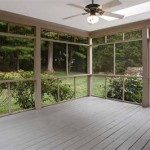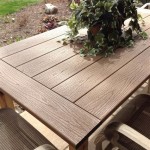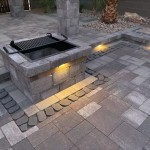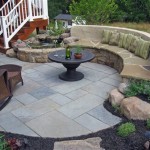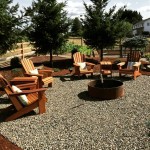How To Finish Cement Patio Slabs
A well-finished concrete patio enhances a property's aesthetic appeal and provides a durable, functional outdoor space. Achieving a professional-looking finish requires careful planning and execution. This article outlines the essential steps for finishing cement patio slabs, covering various techniques and considerations for a successful project.
Preparation is Key: Before any finishing work begins, the concrete slab must be properly prepared. This involves ensuring the concrete has reached the appropriate stage of curing. The concrete should be hard enough to walk on without leaving impressions, but still soft enough to be worked with. Testing the concrete's readiness can be done by pressing a fingernail into the surface; a slight indentation indicates it's ready for finishing.
Screeding: Screeding is the first step in the finishing process. A straight edge, typically a 2x4 or magnesium screed, is used to level the concrete surface. The screed is moved back and forth across the surface, removing excess concrete and filling low spots. This process establishes a flat, even plane.
Bull Floating: After screeding, bull floating further refines the surface. A bull float is a large, flat tool, often made of magnesium or aluminum, attached to a long handle. It's used to smooth out any ridges or imperfections left by the screed. Bull floating also embeds larger aggregate particles and helps to bring a thin layer of cement paste to the surface, facilitating subsequent finishing steps.
Edging: Edging creates a rounded, beveled edge along the perimeter of the slab. An edging tool is used to create this rounded profile, preventing chipping and providing a more finished look. Edging should be done immediately after bull floating, while the concrete is still workable.
Jointing: Control joints are essential for managing the inevitable cracking that occurs in concrete due to shrinkage and temperature changes. These joints are typically cut into the slab using a groover or saw, creating weakened planes where the concrete can crack in a controlled manner. The spacing of control joints depends on the slab's thickness and other factors. A general guideline is to space joints at intervals no more than 2-3 times the slab's thickness.
Floating: Once the concrete has stiffened slightly, floating further compacts and smooths the surface. Hand floats, made of wood, magnesium, or resin, are used in a circular or back-and-forth motion to close up any remaining voids and create a smoother finish. This step also helps to embed any remaining coarse aggregate.
Troweling: Troweling produces a dense, smooth, and hard-wearing surface. Steel trowels are used for this final finishing step. The timing and number of troweling passes depend on the desired finish. A single pass creates a slightly rougher texture, while multiple passes result in a smoother, more polished surface. Over-troweling, however, can weaken the surface and lead to surface defects.Broom Finishing: For a non-slip surface, a broom finish is often applied. After the concrete has been troweled, a broom is drawn across the surface, creating a textured finish. The coarseness of the broom determines the texture's depth. A soft-bristled broom produces a finer texture, while a stiffer broom creates a more pronounced, slip-resistant surface.
Curing: Proper curing is crucial for the concrete's long-term strength and durability. Curing involves maintaining adequate moisture and temperature for a specific period, typically 7 days. This allows the concrete to hydrate fully, achieving its maximum strength. Common curing methods include covering the slab with plastic sheeting, applying a curing compound, or keeping the surface continuously moist with water.
Finishing Choices: Several finishing options are available to achieve different aesthetic effects. Stamped concrete mimics the look of various materials, such as brick, stone, or wood. Exposed aggregate finishes reveal the decorative aggregate within the concrete mix. Colored concrete can be achieved by adding pigments to the concrete mix or applying stains to the finished surface.
Sealers: Applying a concrete sealer provides additional protection against stains, moisture, and weathering. Sealers are available in various formulations, including water-based, solvent-based, and acrylics. Choosing the appropriate sealer depends on the specific application and desired level of protection.
Tools and Equipment: Using the right tools and equipment is essential for achieving a professional-looking finish. Investing in high-quality tools, such as screeds, floats, trowels, and edging tools, will facilitate the finishing process and contribute to a superior result.
Safety Considerations: Working with concrete requires adherence to proper safety precautions. Wear appropriate personal protective equipment, including gloves, eye protection, and dust masks. Be mindful of wet concrete surfaces and potential trip hazards. Follow manufacturer's instructions for the safe use of tools and equipment.

How To Finish A Concrete Patio Slab Fine Homebuilding

Pouring And Finishing A Concrete Patio Slab For Beginners

How To Form Pour And Finish A Concrete Patio Slab

How To Pour A Concrete Backyard Patio Slab Beginner Guide

How To Create Faux Tile Look On Concrete Patio Southern Hospitality

How To Pour A Concrete Slab For Beginners Diy

How To Install Pavers Over A Concrete Patio Family Handyman

Finishing Concrete For 3 Patio Slabs And 2 Garage Floors Is Easier Than You Think Here S Why

Diy Concrete Patio In 8 Easy Steps How To Pour A Cement Slab

How To Stencil Concrete Garden Paving Slabs Start Finish Tutorial



